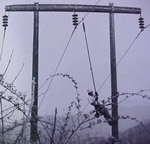 |
|
|
In the early twentieth century,
rural electrification in the mountain region of North Carolina was sporadic
and haphazard. Several emerging municipalities in the westernmost counties
of the state found it difficult to find suppliers that were equipped
to sustain the demand while also maintaining reasonable rates. Distribution
into the rugged terrain was expensive and labor intensive, thus it progressed
slowly. Electrification of rural areas increased dramatically with President
Franklin Roosevelt's New Deal programs. Like the rest of the nation,
this region sought to benefit from these programs that were to bring
[the Appalachian mountaineer] some of the things he needs, like schools
and electric lights. |
|
© Western Carolina University
NOTICE: WARNING CONCERNING COPYRIGHT RESTRICTIONS The digitalized exhibit ìWatts in The Mountains: Rural Electrification in Western North Carolinaî is the sole property of Western Carolina University. As such, all materials presented in this exhibit are protected under the current law of the United States (Title 17, U. S. Code) that governs the making of copies or other reproductions of copyrighted material. Fair use under the law permits reproduction of single copies for private study or research. Further transmission, reproduction, or presentation of protected items without the written permission of the copyright owners is forbidden This institution reserves the right to refuse any additional copying petitions if, in its judgments, fulfillment of the request would involve violation of the copyright law.
Web design by DarkCove
